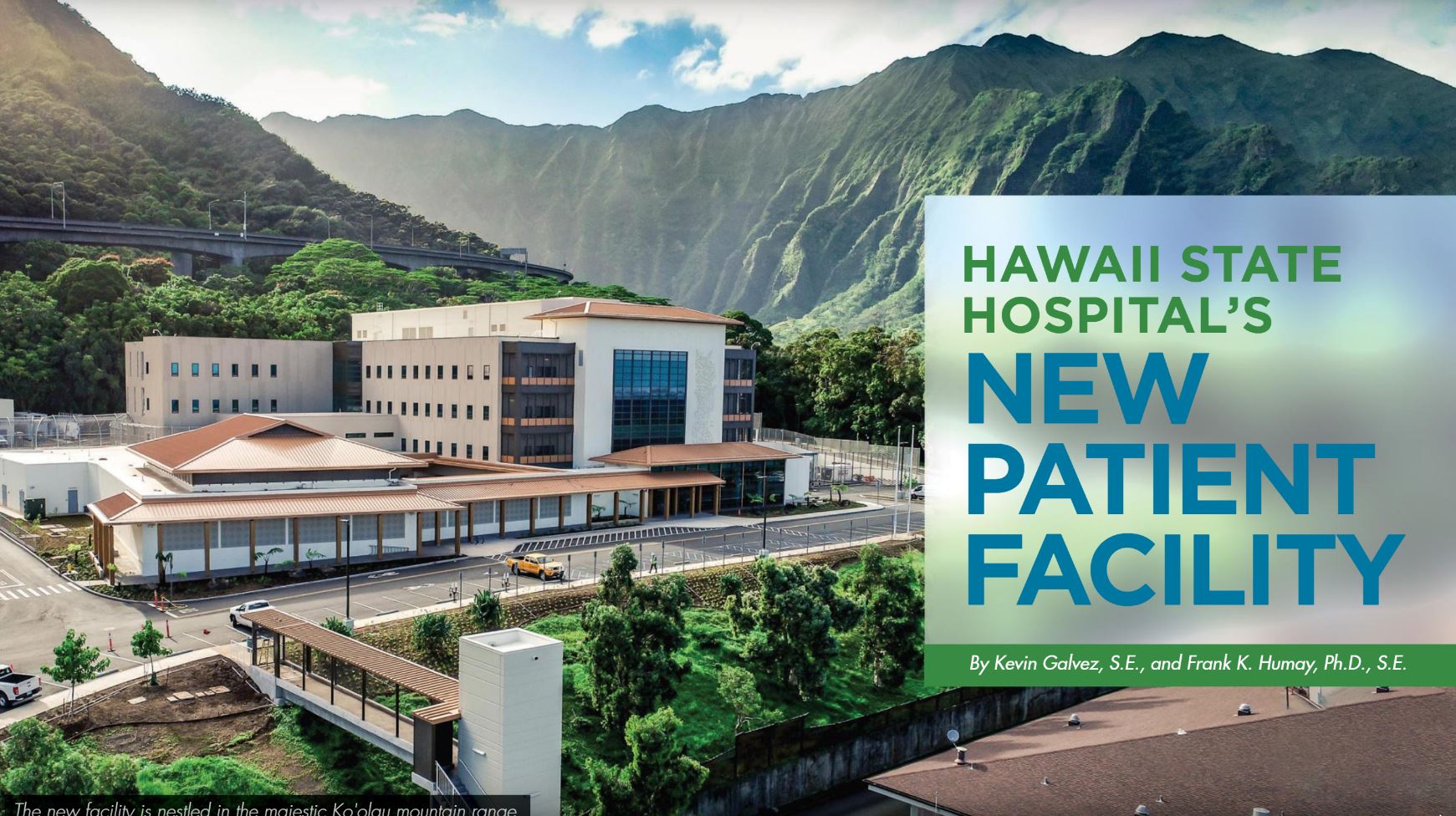The $160 million New Patient Facility at the Hawaii State Hospital is a four-story, 144-bed, 196,944-square-foot secured psychiatric facility on an existing psychiatric hospital campus. At the foot of the Ko’olau Mountain Range, this facility includes patient care units, a rehabilitation mall, multiple office spaces, a standalone central utility plant, a separate gymnasium for recreational therapy, and a site elevator with a walkway bridge structure. Due to the ever-increasing patient population and a high percentage of high-risk forensic patients, the existing hospital could not keep up with the demand, and a larger facility was needed. The project was executed using the design-build delivery method led by Hensel Phelps.
Building Description
The 63-foot-tall main building measures 310 feet in the north-south direction and 384 feet in the east-west direction. The building’s footprint is not the typical rectilinear shape. Instead, six patient wings extend out from the center core of the building (Figure 1). The separated patient wings were formed in such a way to provide protection and privacy for select groups such as women, the elderly, and violent patients.
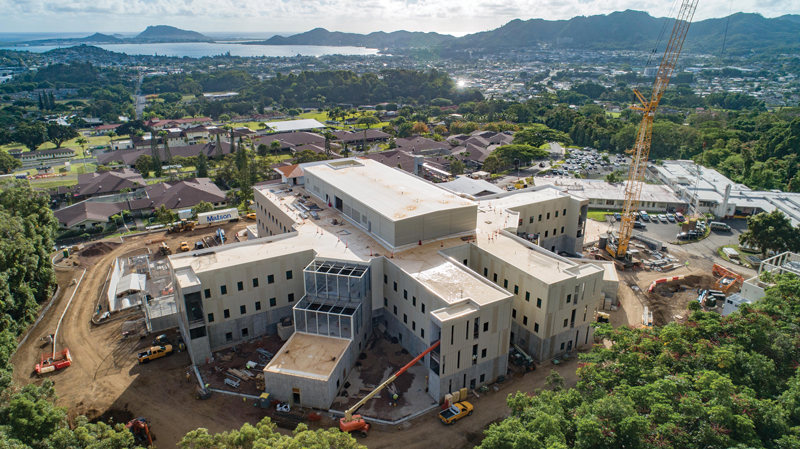
The ground floor spaces serve various functions, including a chapel, courtroom, library, multiple offices, art rooms, kitchen and dining spaces, and a secured outdoor rehabilitation mall. Levels 1 through 3 consist of wings for patient living and multiple office spaces.
The design follows the 2006 International Building Code (IBC) with amendments by the City and County of Honolulu. With a building classification of Occupancy Category III, the building is designed for a basic wind speed of 105 mph and a Seismic Design Category C. Due to the building’s irregular shape, a modal response spectrum analysis was performed to determine the seismic loads on the structure.
Structural System
The project site is where an existing hospital building was demolished. The building foundation consists of shallow spread footings on in-situ residual and saprolite soils. Upon excavation, it was discovered that the excavated soil could not achieve the same strength characteristics of the in-situ material and could not be used as structural fill. Instead, the excavated soil was mixed with crushed concrete to attain the soil bearing capacities required for the loads imparted by the building.
The facility must be highly resilient to protect the patients, staff, visitors, and greater community from environmental and man-made threats. Therefore, the primary structure must be capable of resisting forces from earthquakes, hurricanes, and the continuous onslaught of a corrosive tropical environment. In addition, the structure must be of durable construction that minimizes future maintenance but still provides an aesthetically pleasing form. The original concept for the facility utilized load-bearing CMU walls in place of precast concrete walls at the facility’s exterior and all interior stair/elevator cores. Although slightly more costly than CMU, precast concrete walls saved considerable construction time and were the best choice for Hawaii’s remote location.
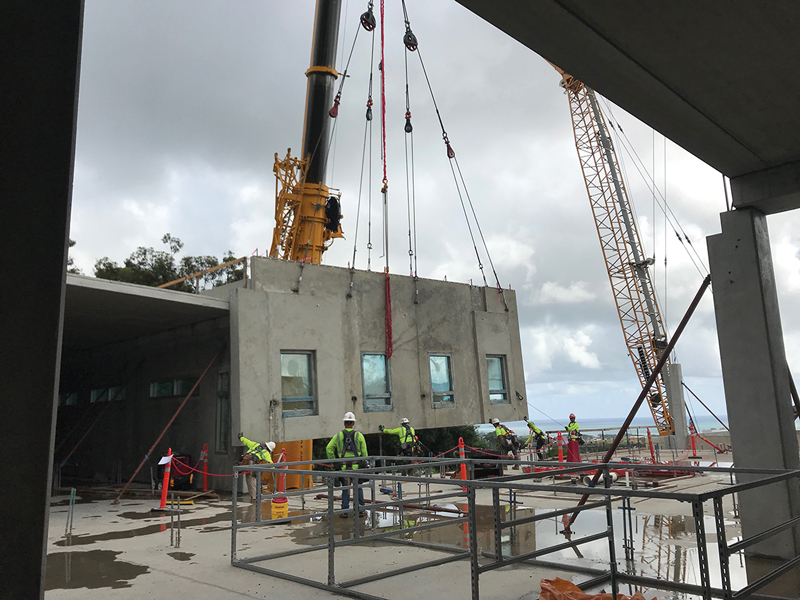
The primary structure consists of load-bearing exterior precast concrete walls and interior precast concrete columns supporting a floor system with precast concrete hollow core planks at typical locations and double tees at heavier loaded areas with longer spans (Figure 2).
Precast concrete facilitated construction by allowing portions of the building to be fabricated offsite, then delivered and assembled on-site with minimal interruption due to weather. It also provides an efficient structural system with the strength to support all floor/roof loading, including the weight of substantial non-load bearing concrete masonry partition walls, and the rigidity to limit deflections and control perceptible vibrations. Furthermore, precast concrete is an inherently durable material detailed to withstand the corrosive tropical environment of Hawaii and ease future maintenance. The building foundation consists of shallow spread footings such as isolated column footings, continuous wall strip footings, and mat footings at elevator cores. The roofs of the mechanical and elevator penthouses consist of a bare metal deck supported by structural steel beams. In contrast, the gymnasium roof consists of a bare metal deck supported by structural steel trusses.
The lateral force-resisting system mainly consists of intermediate precast concrete shear walls. The structural diaphragm, which distributes and transfers laterals forces to the shear walls, consists of a 4-inch cast-in-place concrete topping at typical floors and a 3-inch cast-in-place concrete topping over precast framing at roof diaphragms.
Constructability and Design Challenges
Located in the city of Kaneohe on the east side of Oahu, the site receives a substantial amount of rain and moisture. On-site CMU construction would have unacceptably delayed the project. The use of precast concrete allowed the project schedule to be maintained and ultimately saved about six months on the schedule.
Precast concrete was also the best choice for Hawaii’s remote location. Other gravity load-resisting systems (structural steel and cast-in-place (CIP) concrete) were evaluated for this project, but precast concrete was the optimal choice to meet budgetary and schedule restraints for several reasons. Precast concrete is locally sourced and manufactured, whereas structural steel must be fabricated on the mainland and shipped to Hawaii. Any major field issues during erection are much more difficult and time-consuming to address with structural steel since required materials may not be locally available. The need for fire-proofing was also a drawback for structural steel. The factors mentioned above and potential delays due to shipping made the locally produced precast a more attractive option. Like precast concrete, CIP concrete is locally sourced. However, with the wet and rainy conditions at the site, cast-in-place concrete construction faced schedule issues similar to those with CMU, such as fewer available days for construction.
Several structural challenges were efficiently addressed with the use of precast concrete. The Occupancy Category III structure is subjected to moderate to high seismicity, hurricane-force winds, and a corrosive tropical environment. The use of load-bearing precast concrete walls at the exterior of the facility simultaneously addresses these forces and the environmental factors. The intermediate reinforced precast concrete walls are designed as shear walls for resistance to in-plane earthquake (and hurricane) forces. The walls also resist out-of-plane hurricane-force winds and are detailed to withstand Hawaii’s climate with minimal future maintenance. The climate and tropical environment in Hawaii facilitate accelerated corrosion, partly due to the higher amount of chlorides in the atmosphere and the humidity. Several measures were taken to slow down the corrosion rate, such as using hot-dip galvanized steel when exposed to weather or in unconditioned spaces, using zinc-rich paint coating where field welds could not be avoided, and applying multiple coats of elastomeric coatings at exterior faces of the precast concrete walls. In addition, the precast concrete mix used very low w/c ratios (w/c = 0.35) and included fiber reinforcement to help increase the concrete durability. Precast concrete wall panels were also provided with prestressing strands to help control cracking.
Security for patients, staff, and the community is a critical design consideration for a psychiatric hospital. The exterior shell of the facility (i.e., all exterior walls and roofs) had to meet stringent security requirements such as limitations to reinforcement bar spacing as required in the Facility Guidelines Institute’s (FGI) Guidelines for Psychiatric Hospitals and the FGI Design Guide for the Built Environment of Behavioral Health Facilities. Achieving the requirements for vertical enclosures using load-bearing precast concrete wall panels was very efficient. The size and spacing of the reinforcement steel were slightly adjusted to meet the security requirements, but this did not add any appreciable cost to the panels. Precast concrete eliminated the need for thick steel security panels at the exterior of the building, which would be required if non-load bearing lightweight framing was used. Furthermore, the floor system of 8-inch-thick hollow-core precast sections with cast-in-place concrete topping satisfied the security requirements without any additional enhancements.
Another design challenge was creating an exterior aesthetic that presents a non-institutional, non-threatening character sensitive to public perceptions and responds to Hawaii’s climate, environment, culture, and customs. The precast concrete wall panels provide visual interest, scale, and delight through various configurations and finishes. Form liners were used on the panels along the main walkway at the front entrance to introduce a Hawaiian Piko pattern. Piko in Hawaiian is another word for the navel where life begins, and the symbol brings new life and purity to the world. It also represents peace, tranquility, spirituality, and a strong sense of regrowth or new beginnings. The intricate repetitive design cast into the precast panels creates a unique Hawaiian sense of place for all those entering the facility.
It was crucial that this high-security facility integrate into the architecture of the existing surrounding hospital buildings and that the building’s overall form was sensitive to the neighboring community and displayed a Hawaiian sense of place. The use of precast concrete wall panels with various finishes and reveal patterns accomplished this goal without compromising strength, durability, or security.
Innovations and Accomplishments
This was the first project that the precast manufacturer (GPRM) cast the window frames, including the glazing, into the panels with the concrete pour. In researching other precast producers, this may have been the first time this was done with the glazing already in the frame. This technique required a new and enhanced level of attention in planning, detailing, and executing the precast fabrication work to protect the glazed window units and circumvent breakage during production, handling, transporting, and erecting the panels (Figure 3).
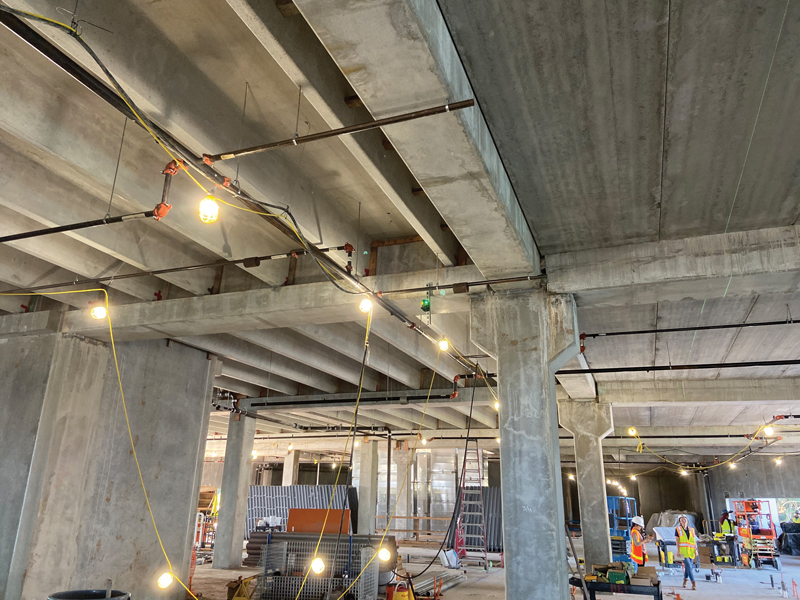
This novel approach to installing the window units compressed the schedule and allowed the building to be enclosed from the elements much quicker. With the windows cast together with the wall panels, a higher level of quality control than field installation was achievable, enhancing the interface’s quality and durability between windows and walls. In addition, the prefabricated security window assemblies are operable, allowing for natural ventilation while incorporating enhanced security features such as special handles that cannot be used for self-harm and that eliminate the possibility of passing contraband or throwing things from windows.
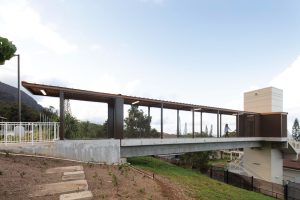
The standalone site elevator/stair tower and bridge structure are simple but unique designs allowing staff and guests to access the new facility from the lower campus levels. The elevator tower consists of stacked precast concrete wall panels forming a core. A 32-inch-deep precast double tee bridge spans from the elevator tower to the upper-level abutment. The bridge is covered by a lightweight steel canopy supported by the bridge structure. The precast concrete stairs wrap around the elevator tower and are supported using flag walls, concrete wall segments cast with the wall panel that cantilever from the panels. See Figure 4 for the bridge structure and site elevator/stair tower with flag walls. The unique flag wall design eliminated exterior support columns, which would have been difficult to install within the tight footprint, and reduced the cost of the tower.
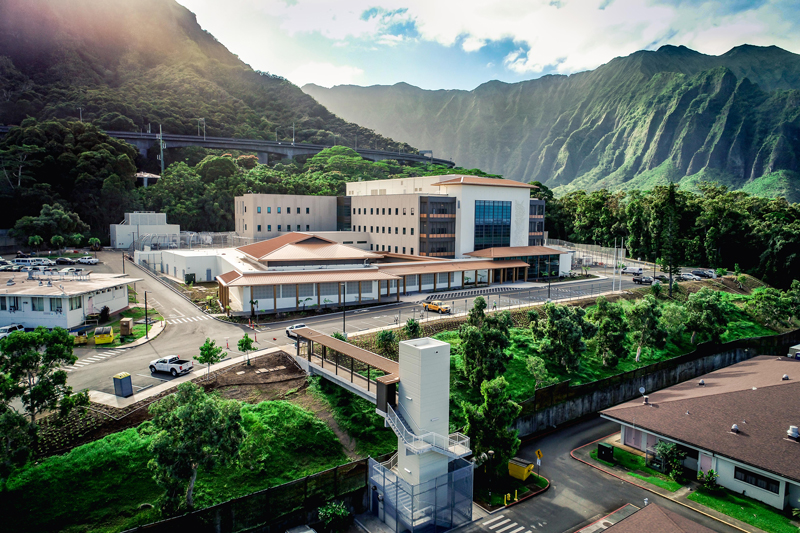
Conclusion
Through the constant collaboration of the design-build team and the adaptability afforded by the design-build delivery method, the construction of the Hawaii State Hospital New Patient Facility was completed on time and within budget despite the challenges faced. Although not evident initially, the precast option with a higher material cost resulted in an efficient design, saving the project time and other associated costs inherent in concrete properties. It is not always the lowest cost structural system that produces the most efficient and economical design. This also highlights the benefits of the design-build process. Without the Contractor’s input, there would have been significant impacts on the schedule, and structural work may not have gone as smoothly.■
Project Team
Owner: State of Hawaii, Department of Health
Structural Engineer of Record: BASE
Architect of Record: G70
General Contractor: Hensel Phelps
Precast Concrete Supplier: GPRM Prestress
